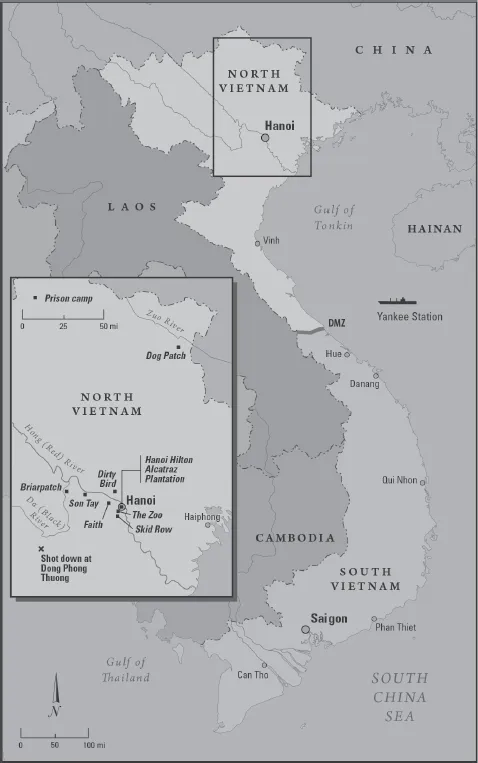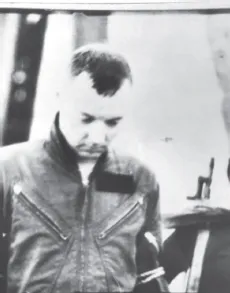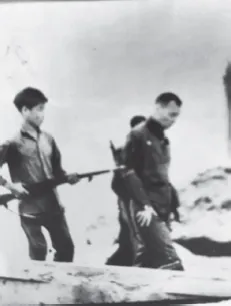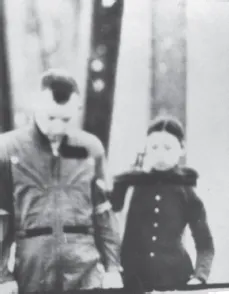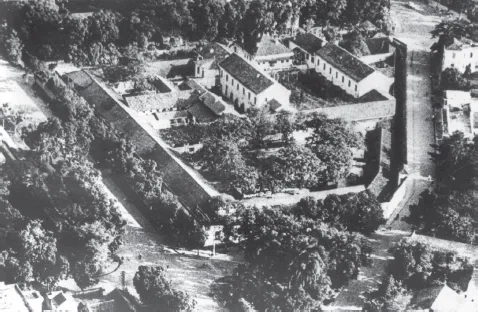![]()
Part 1
Vietnam prison camps and other important locations during the Vietnam War. (Commissioned for the author, Erin Greb Cartography, 2017)
![]()
Chapter 1
A Flash of Orange Light
Aboard Aircraft Carrier Kitty Hawk at Yankee Station, off the Coast of North Vietnam, January 1967
Fighter pilots at war don’t have time to miss their families. Three weeks after Christmas in 1967, my wife and two small children were halfway around the world, and I was pretty busy myself, intently focused on the task before me: bomb and destroy a series of bridges in the rural northeastern region of North Vietnam. President Richard Nixon had temporarily stopped our US assault because of the holidays, but US jets still continued to attack areas of South Vietnam, which remained occupied by the Viet Cong. We bombed a few obscure targets, being directed by air controllers flying their small observation planes, but when the weather was bad, we were often kept airborne in our trusty A6s.
Just past the middle of January, the weather started to improve, so a large air strike was planned for the nineteenth. Two carriers would participate, each launching three strikes, for a total of six. Normally, strike assignments would come from headquarters in Saigon. Our air wing staff would assign the squadrons that would participate. Then, a strike leader was tasked with briefing the participants on overall tactics, and the A6 contingent would generally serve as the navigation lead to the target area because of our inertial navigation systems. On the first strike of that day, I led the whole strike force to the target area. The strike leader commanding the F4s (fighter group) initiated the attack phase. I was in the lead section of four A6s (attack group). There were F4s and A4s as well, for a total of about twenty aircraft. As we approached the target, I could see the telltale smoke puffs of antiaircraft artillery. We descended to about three thousand feet and went to full power. The F4s on our tail hit burners and passed us. Some A4s were attacking antiaircraft artillery sites with 20 mm guns and rockets. A4s had launched Shrike antiradiation missiles, which home in on the enemy radar signals, launching them high in the air where they would leave contrails. Of course, the enemy could see the missiles, but they would have had to either shut down their radars or have a Shrike missile down their chimneys, so to speak. Unexpectedly, our missile warning light came on, indicating that a surface-to-air missile had been launched at us and was receiving guidance information. The F4s came on the radio and ordered our group to hard turn to port. Shortly after I had the target in my sight, I radioed that I was pulling up, and then all the A6s pulled up as well to gain sufficient altitude to roll into a divebombing maneuver. I acquired the target in my crosshairs and pushed the release button at three thousand feet, then I pulled out and immediately jinked to the left, doing more than four hundred knots. Suddenly, I heard an explosion and saw a flash of orange light. With a jarring thump, the control stick was ripped out of my hand, and although I tried to grab it and continue maneuvers, it gave no response. The aircraft started rolling violently, and I knew it was time to get out.
The A6 Intruder has a large canopy that slides rearward on release. When you start an ejection sequence, the canopy slides back and keeps going, eventually leaving the aircraft completely. To initiate the ejection sequence, you are supposed to reach for a yellow handle on the instrument panel in front of you to get rid of the canopy and then pull one of the two available ejection handles, either the one over your head or the one between your legs. After I was hit, the g-forces were so great that I couldn’t reach the canopy handle, so I reached for the handle over the back of my head. It was difficult, but I knew that if I didn’t find it, that would be it for me! I managed to grab onto it and then pulled as hard as I could. There was a vacuous noise and then a wonderful acceleration as I blasted through the canopy. The top of my seat was higher than my head, so it busted through the canopy first. (Actually, if the rails had been damaged, the canopy might have gotten stuck halfway, and I would have crashed up inside of it, another way to die.) My bombardier navigator, Lt. Cdr. Bill Yarborough, who was a skilled navigator and also a great friend, ejected as well. He and I never spoke again, as the g-forces made it impossible for us to talk to each other as we spiraled downward. After I ejected from the plane, several things happened, all of them occurring in no more than a few seconds. When my chute finally deployed, I looked down and saw that the ground was only about a hundred feet below me. I prepared to execute a hard parachute fall, but since there was no wind, I was unable to roll when I hit the ground, and I crashed in a sitting position, which was quite painful. I saw the smoking hole in the ground about a hundred yards from where I landed, the remains of my aircraft. I called out for Bill but got no response. He must have died on impact, his chute failing to deploy fully before he hit the ground. I could see Vietnamese people running toward me, but I was in a wide-open country of rice paddies, with no avenue of escape. I knew I would be captured. The report Lt. Ron Waters, the pilot in the plane behind me, submitted to Navy officials after the crash stated that he saw my aircraft when it was hit and watched it break into two burning pieces and then fall to the earth.
Back home, my family members held their collective breath for nineteen months, wondering if I had survived.
![]()
Chapter 2
Heartbreak Hotel
New Guy Village, Hỏa Lò Prison
When the Vietnamese arrived at the crash site, they jumped on top of me and brought me into submission on the ground. I landed hard on my back in a rice paddy field, and as they snatched and grabbed at my hands and feet I struggled to keep them from pushing me down into the nearby water. At first, I feared they were going to drown me on the spot, yet another way to die. Some of them held me down while the others yanked off my flight boots and ripped the parachute vest from my body. It was a group of five or six men, all of them pretty petite in stature, thankfully. They lifted me to my feet, tied a tattered piece of cloth across my eyes and nose and tied my arms so tightly with old rope that I could feel the chafing almost immediately.
Then they marched me to their village about a half a mile up a nearby hill. Once there, I was made to stand in front of someone I assumed must have been their village chief. I couldn’t see him because I was blindfolded. Whoever he was, he clearly believed me to be his enemy. Without saying a word to me or to anyone, and without any warning, he punched me in the jaw with an ire intense enough to take me all the way down. He said nothing to me after either. Then my captors escorted me to a small building in the interior of their village and had me sit down on a low wooden bench. My blindfold was removed, and I found myself in a tiny room about the size of a toolshed. The floor was dirt, and there were three or four other people squeezed in there with me. Several young men from the village came up to take a closer look at me, curious, like I was a circus oddity. When one of them offered me a cigarette, not wanting to offend, even though I was not a smoker, I smoked it.
I knew that wherever we were, it wasn’t very far from the bridge I’d bombed. I also knew that the same location would be targeted again later that day. Consequently, I had to sit quietly and wait for the explosions to come, anticipating, correctly, that I was also going to have to suffer through the next round of terror with the rest of these guys. About a mile from where I was being held, the A6 contingent continued to drop thousand-pound MK83 bombs and rattle the earth around me. When it was finally over, I was marched out of the village and we headed to a new site for the night. My state of mind was pretty good by this point, because I finally felt in my gut that if they were offering me a smoke and moving me to different locations, they probably weren’t going to kill me. If I’m honest, I was a little numb, too, and in reflection I think my calm was perhaps a result of exhaustion more than consolation. It was astonishing for me to relive what happened as those hours in captivity finally started to settle in: one minute I was traveling at four hundred knots, heading for home on the carrier, and a moment later, there I was on the ground, a hostage in enemy territory, captured. I was someone’s prisoner. I felt tangible relief that I’d survived the crash; I was alive! But there was also the ominous dread of the unknown hours ahead and of what was going to happen to me. I felt acutely aware that this was not survival school. This was not part of any military training or prisoner simulation exercise. This was not one of the nightmares of my dark imagination, when my shipmates and I would joke around about getting shot down on a mission and what we’d do if we were captured, hypothetically speaking. I was in the middle of the real thing, and I’m not ashamed to admit that I wished I were elsewhere.
Shootdown and capture, January 19, 1967. (US Department of the Navy)
As they led me along that afternoon, we passed through a few small villages scattered about on our way to the next stop. An advance team of theirs had arrived a bit before us and rallied all the locals to come out and line the pathway as I walked by. They shouted things at me in a language I couldn’t even begin to understand, and they threw stones at me. Although the Vietnamese are actually a fairly tranquil people by nature, instinctively I could see that when provoked, like they were tonight, they were certainly prepared to fight and defend their country against someone like me. Even though all that hostility and those threats to me felt somewhat staged, my captors believed their anger was still absolutely justified. We walked on. I spent that night in a small, locked building in a village about two miles from where I was captured. Even though the American A6s were covering the countryside day and night looking for moving targets, the chance of being detected was much lower at night than in the daytime. I figured we probably weren’t traveling more frequently because someone up the North Vietnamese chain of command didn’t even know I was a captive yet, and motorized travel would be necessary if they wanted to find me and take me on to Hanoi.
Another day passed. We traveled by truck until dark, and then we spent the night in what looked like a grain-storage building. The next morning, we traveled briefly before stopping at a bridge surrounded by Vietnamese people who appeared to be public relations staff or maybe members of their local media. Then, in a completely staged propaganda opportunity, I was forced to walk across the bridge with a tiny Vietnamese girl, who was coached to carry a rifle and to keep prodding me with it, acting as though she was the one who captured me. It was designed to be humiliating, and I was forced to look totally submissive. A photographer there was filming the whole event with a movie camera, and I was glad about that cameraman—I was thinking my picture might get out if their film was actually circulated. Sometime later, sure enough, someone in our government received the footage, and it was the proof the Navy needed to confirm that I was captured but still alive.
After this, I was taken to yet another house, where I was made to lie on the dirt floor, still bound with rope at my hands and now also at my feet. All during the day, Vietnamese villagers would come in and out to gawk at me. Some of the more curious ones would even get a few licks in by kicking me in the legs. It wasn’t serious kicking, more of an aggravation than anything, and I knew their intentions were not really to hurt me. I was fairly sure, even in the middle of their harassment, that I would live another day, so it was tolerable for that reason only. When our time together in those rooms got quiet, and in the moments when my captors and I were allowed a respite from the burden of my captivity, I often wondered silently, Why am I being spared? And then, How would one of these men fare in my country if the tables were turned?
Another night was spent in the back of another truck, and it was rather cold, since it was January. I was thankful I still had my socks on, and I was also still wearing my flight suit, but they’d taken my boots, and we’d been walking for days and days. The fatigue and that bitter cold started getting to me, and in moments throughout that night I felt sure I might freeze to death. Mentally, the exhaustion was catching up with me, too, but still, on each one of our marches I paid extremely close attention to how the terrain changed, trying constantly to keep my bearings. Of course it was dark each time we traveled, but at one point I ascertained that we’d crossed a river on a fragile, moveable bridge that could be put in place and disassembled quickly on short notice. I made note of things like that over and over, in case I needed that information for later. Every single detail seemed important.
We finally arrived at Hỏa Lò prison (pronounced wa low), which was built by the French when they occupied Vietnam from 1887 to 1954. At the time of French occupation, the country was called French Indochina. This prison was decrepit and dingy and looked like the dungeon from an old horror movie, poorly lit and dank. When we arrived, it was early morning and still dark. I could hear a radio blaring Vietnamese music, which sounds eerily like Middle Eastern religious chanting. Creepy as hell. The building was made of masonry, with chilly brick pathways, lit with incandescent lights that made everything impossible to see. I was forced to sit on the cold, unforgiving floor with my back up against the wall, tied up like an animal for the rest of the day and night, until daylight came seeping through small windows in the wall the next morning.
Hỏa Lò prison, aerial view, 1970. (US Department of the Navy)
You’re still alive. It was a hushed voice in my head that became an ever-present consolation to me, a hundred times a day, from that moment on. A reminder that I had a future to look forward to. I still had my life.
The following morning, I was given a small bowl of plain rice and some tea in a metal cup. When there was finally enough light to see the things around me, I noticed a large hook hanging from the ceiling in the corner. I wondered what it was and then hoped it was not what I thought it might be. I sat by myself in that cell for a good long while before the Interrogator finally came in. He wore a light-colored jacket and pants and appeared to be an officer of some sort. His dress was more refined than that of anyone else I’d come into contact with thus far, and he carried himself differently than the locals. He spoke fairly decent English, and his demeanor was strictly business. His voice was low and calm, eschewing friendly small talk. He had one of his assistants tie me up around the ankles, with my legs extended straight out in front of me. Then my arms were bound tighter behind my back, with the rope around my elbows now, too, which I knew couldn’t be a good sign. Then the assistant cinched it and wound it up and around my neck. Finally, a stick was placed through the knot at my elbows.
The Interrogator asked me which ship I’d come from. Like a good soldier would, or should, I answered him with only my name, rank, and serial number. He then called out for someone else, and in walked a Vietnamese soldier wearing a pith helmet adorned with a net and leaves, the kind that would be used as camouflage. He was undoubtedly of a lower military rank, something I assumed by his rumpled uniform and lack of English skills. I would come to know this man as “Flower Hat,” and he is someone very well known to all American POWs who ever passed through New Guy Village at Hỏa Lò, which is where I had the misfortune of being at that moment. The Interrogator left the room displeased with me and Flower Hat proceeded to administer his famous rope trick, which had several variations. First, he held the stick that was lodged in the rope behind my back and twisted it clockwise, which tightened the rope around my neck and forced my neck backward and down, and then the circulation in my arms stopped. I began...

